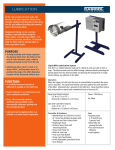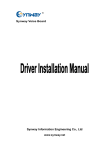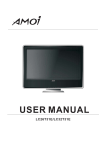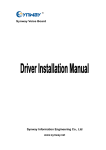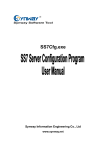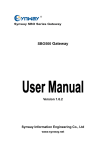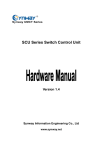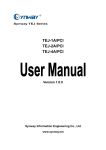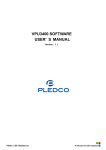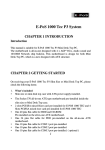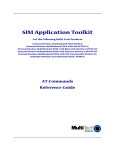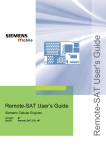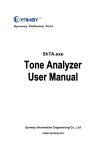Download 2.2 Recording Raw Waves/Raw Data Flows
Transcript
Synway Software Tool Synway Information Engineering Co., Ltd www.synway.net Synway Information Engineering Co., Ltd Contents Contents ...................................................................................................i Copyright Declaration............................................................................ii Chapter 1 Overview...............................................................................1 Chapter 2 Operation Guide ..................................................................2 2.1 2.2 2.3 Recording Signaling Messages (applicable to Common Working Mode) .....................2 Recording Raw Waves/Raw Data Flows (applicable to Raw Data Acquisition Mode) 11 Recording Bit Streams (applicable to Common Working Mode) .................................18 Chapter 3 Troubleshooting ................................................................20 Appendix A Example of Signaling Content........................................23 Appendix B Example of Standard Raw Wave......................................24 Appendix C Technical/sales Support .................................................26 CasTool User Manual Page i Synway Information Engineering Co., Ltd Copyright Declaration All rights reserved; no part of this document may be reproduced or transmitted in any form or by any means, electronic or mechanical, without prior written permission from Synway Information Engineering Co., Ltd (hereinafter referred to as ‘Synway’). Synway reserves all rights to modify this document without prior notice. Please contact Synway for the latest version of this document before placing an order. Synway has made every effort to ensure the accuracy of this document but does not guarantee the absence of errors. Moreover, Synway assumes no responsibility in obtaining permission and authorization of any third party patent, copyright or product involved in relation to the use of this document. CasTool User Manual Page ii Synway Information Engineering Co., Ltd Chapter 1 Overview CasTool.exe is a special tool we provide to help solve problems involving the digital station tap board, primarily used in: 1. Logging signaling messages for the digital phone, monitoring channel states and recording on-channel voices (applicable to Common Working Mode). 2. Recording raw waves or raw data flows (applicable to Raw Data Acquisition Mode). 3. Recording bit streams (applicable to Common Working Mode) At present the models of digital station tap boards are as follows: 1. A-type: SHR-16DA-CT/PCI, SHR-24DA-CT/PCI 2. B-type: DST-24B/PCI, DST-24B/PCI+, DST-24B/PCI(2.0), DST-24B/PCI+(2.0), DST-24B/PCIe(2.0), DST-24B/PCIe+(2.0) The two working modes mentioned above are described as follows: 1. Common Working Mode: It is selected in case that the check box before ’Rec Raw Mode’ is not ticked when using ShCtiConfig.exe to configure such information as PBX model, etc. In this mode, you can perform the recording of signaling messages (applicable to both A-type and B-type boards) or bit streams (applicable only to B-type boards). The bit stream is the effective raw data composed of voice data and signaling messages, generated by parsing the original waveforms. 2. Raw Data Acquisition Mode: It is selected in case that the check box before ’Rec Raw Mode’ is ticked when using ShCtiConfig.exe to perform configuration. Note: SHR-16DA-CT/PCI and SHR-24DA-CT/PCI digital station tap boards, if working in Raw Data Acquisition Mode, support the acquisition of raw data flows, that is, collecting digital signals 0 or 1 at a specified rate. Some operations on parameter configuration may be required to enable this feature. Please contact us (see Appendix B) for help when necessary. DST-24B/PCI, DST-24B/PCI+, DST-24B/PCIe and DST-24B/PCIe+ digital station tap boards, if working in Raw Data Acquisition Mode, support the acquisition of raw waves, that is, performing the A/D conversion sampling to on-line raw waves at the rate of 10M/S. This software cannot run without ShConfig.ini and ShIndex.ini, so you must configure ShConfig.ini properly for the digital station tap board according to the description in the document ‘DSTBoard_Config_Manual.pdf’, which can be downloaded from the link below: http://www.synway.net/DownLoad/DST_help_document.rar CasTool User Manual Page 1 Synway Information Engineering Co., Ltd Chapter 2 Operation Guide 2.1 Recording Signaling Messages (applicable to Common Working Mode) Step 1: Start CasTool.exe and the main interface shows as Figure 2-1. Figure 2-1 As seen in Figure 2-1, there are two columns ‘TestInfo’ and ‘ChInfo’ on the top of the left list window. The ‘TestInfo’ will cover such information as Ch, ChState, DTMF BUFFER, DKEY, LCD INFO, CallerId and CalledId, while the ‘ChInfo’ will show the monitored situation in real time. The right list window will display the D-channel event code and other parameters in turn. The item ‘Event Filter’ at the bottom is used to set conditions for which events you exactly want to display. For example, if you only want events with the event code of 1008 and 104a to be displayed, fill in ‘1008 104a’; if you want all events but those with the event code of 1008 and 104a to be displayed, fill in ‘1008 104a’ and tick the check box ‘Exclude’. Note that up to 10 event filter conditions can be set at a time and the filled-in event codes should be separated by blank space. Step 2: Fill in some parameters under ‘Channel Info’ as shown in Figure 2-2. CasTool User Manual Page 2 Synway Information Engineering Co., Ltd Figure 2-2 The PBX model, the number of the monitored channel and the phone model are the essential information that you must input (that is, these three fields can’t be left empty). They will be written into the generated log file. For the use of 4-wire digital phones, tick the check box ‘4 wire’; or what you record may only include either uplink or downlink signals. In such situation, please make sure to tick this check box and then perform the recording again. Don’t forget that the correct line connection is the prerequisite for such operation. See relative hardware manuals to find the connection rules for different kinds of 4-wire digital phones. Step 3: If you need recording, tick the check box after ‘EnRecord’ as shown in Figure 2-3. CasTool User Manual Page 3 Synway Information Engineering Co., Ltd Figure 2-3 As long as ‘EnRecord’ is ticked, the program will automatically record A-Law formatted WAV files under the directory of the log file. Step 4: When you finish setting the parameters under ‘Channel Info’, click on ‘Set’ as shown in Figure 2-4. Figure 2-4 Step 5: Then the dialog box of ‘Success to set channel’ will pop up as shown in Figure 2-5. CasTool User Manual Page 4 Synway Information Engineering Co., Ltd Figure 2-5 After the channel is set successfully, a folder named ‘CasFile’ will be generated under the same directory of the program to store the recorded signaling logs and voice files. And the signaling logs and voice files are named in the form of ‘hour_minute_second’, e.g. 15_24_35.log, 15_24_35.wav. As to the format of the signaling content, please refer to Appendix A. Step 6: Click on ‘OK’ back to the main window. Now the button ‘Start’ is activated as shown in Figure 2-6. Figure 2-6 Step 7: At this time, you can click on the button of ‘Start’ to record signaling messages as shown in Figure 2-7. CasTool User Manual Page 5 Synway Information Engineering Co., Ltd Figure 2-7 Step 8: Click on ‘Start’ and enter the interface as shown in Figure 2-8. Figure 2-8 Upon the start of recording signaling messages, do the following operations: perform relevant testing on the digital phone which is parallelly connected to the monitored channel (i.e. the channel with the number set in the previous step), record the testing time, content and the information displayed in the column ‘ChInfo’. Step 9: This step is optional. By setting conditions in the item ‘Event Filter’, the right list window displays only those events that comply with the conditions. For example, if you input ‘1008 1001’ to CasTool User Manual Page 6 Synway Information Engineering Co., Ltd the item ‘Event Filter’, then the right list window (i.e. the D-channel events list) will output those events with the event code of 1008 or 1001. See Figure 2-9. Figure 2-9 If you tick the check box before ‘Exclude’, the right list window only displays the events incompliant with the filled-in conditions. See Figure 2-10. Figure 2-10 When you click the button ‘ClearEvents’, all events that are already shown in the right list window will be cleared out. However, it won’t disturb the display of subsequent events. See Figure 2-11. CasTool User Manual Page 7 Synway Information Engineering Co., Ltd Figure 2-11 When you click the button ‘Event Pause’, the event output is stopped and the button name changes to be ‘Event Continue’. See Figure 2-12. Figure 2-12 If you want the list window to go on displaying the events, click the button ‘Event Continue’. See Figure 2-13. CasTool User Manual Page 8 Synway Information Engineering Co., Ltd Figure 2-13 Step 10: When you finish all testings on the digital phone, click on ‘End’ to stop recording signaling messages as shown in Figure 2-14. Figure 2-14 If the button ‘Cancel’ is clicked, all the files generated in this operation, including both signaling logs and voice files, will be deleted. Step 11: When you click the button ‘End’, the dialog box of ‘Log Information’ pops up as shown in Figure 2-15. CasTool User Manual Page 9 Synway Information Engineering Co., Ltd Figure 2-15 Write down all abnormal phenomena that you ever met into ‘Describe Problem’ and ‘Describe Operation’, such as ‘channel state transition is inaccurate’, ‘fail to detect the calling party number’, etc. In the ‘Describe Operation’, please describe the relevant testings on the monitored digital phone that you did in Step 8 as clear as possible. Then click on ‘OK’ upon completion. Step 12: Go back to the main interface and click on ‘Exit’ to exit the program. See Figure 2-16 below. Figure 2-16 Note: A log file will be generated once the buttons ‘Start’ and ‘End’ are pressed. So during the CasTool User Manual Page 10 Synway Information Engineering Co., Ltd testing process, you need repeat this operation for each call. And each operation will be recorded to an independent log file for our analysis. After you finish the signaling recording, please provide the following materials to our technical support people. 1) The version of the Synway driver (you can check through ‘Property’ of My ComputerÆ ‘Device Manager’ Æ ‘Property’ of board) and the board model; 2) The generated files under the folder ‘CasFile’ (including signaling logs and voice files); 3) The file ‘ShConfig.ini’ loaded for the run of CasTool.exe. 2.2 Recording Raw Waves/Raw Data Flows (applicable to Raw Data Acquisition Mode) The preparation for recording raw waves or raw data flows: Before you start recording raw waves or raw data flows, you must use the driver configuration program to delete unrelated boards, making sure that only those with raw waves or raw data flows to be recorded are remained, and connect lines only to a specified channel on those boards. Note that for 4-wire digital phones, you need perform two recordings of the raw waves for a same operation. Connect the uplink to the specified channel and do the first recording. Then disconnect the uplink and connect the downlink to the specified channel, and do the second recording. For 2-wire digital phones, one recording is enough. The recording of raw waves or raw data flows should be performed in Raw Data Acquisition Mode which can be set by the configuration program in driver. For DST A-type boards, after ticking the check box ‘Rec Raw Mode’, you need to use the button ‘set’ to evaluate the module type with the PBX model that you choose. See Figure 2-17 below. For DST B-type boards, tick the check box ‘Rec Raw Mode’ and choose the closest PBX model (Note: we suggest you choose Alcatel 4200/4400 if your PBX model is not yet supported). See Figure 2-18 below. CasTool User Manual Page 11 Synway Information Engineering Co., Ltd Figure 2-17 For A-type Boards Figure 2-18 For B-type Boards Step 1: Start CasTool.exe and tick the check box after ‘Raw Wave’ (for B-type boards) or ‘Raw Bits’ (for A-type boards). Note: What displays on the interface for B-type boards is ‘Raw CasTool User Manual Page 12 Synway Information Engineering Co., Ltd Wave’ as shown in Figure 2-19, while that for A-type boards is ‘Raw Bits’ as shown in Figure 2-20. Figure 2-19 For B-type Boards Note: Before running CasTool to record raw waves on a DST B-type board, you may need to add configuration items about analog switch to the file ShConfig.ini. For detailed information, contact our technicians. Figure 2-20 For A-type Boards While recording raw data flows on a DST A-type board, you may need to set some parameters. Click on ‘Advance Set’ to go into the dialog ‘Advance Setting’ as shown in Figure 2-21. CasTool User Manual Page 13 Synway Information Engineering Co., Ltd Figure 2-21 Note: The values of these two parameters shown above should be determined by actual situations. For detailed information, contact our technicians. Step 2: Fill in the PBX and phone models and the specified channel number respectively for the items ‘PbxModel’, ‘PhoneModel’ and ‘ChannelNum’ as shown in Figure 2-22. Such information will be saved to the end of the recorded data file. Figure 2-22 Step 3: Click on the button ‘Set’ as shown in Figure 2-23. CasTool User Manual Page 14 Synway Information Engineering Co., Ltd Figure 2-23 Step 4: Now the ‘Start’ button is activated as shown in Figure 2-24. Figure 2-24 Step 5: Click on the ‘Start’ button as shown in Figure 2-25. CasTool User Manual Page 15 Synway Information Engineering Co., Ltd Figure 2-25 Step 6: Then the right area shows the size of the currently recorded data file as shown in Figure 2-26. Normally, the sampling rate for B-type boards is about 10M/S while that for A-type boards depends on parameter settings. Figure 2-26 Step 7: Click on the ‘End’ button to stop acquiring raw data as shown in Figure 2-27. CasTool User Manual Page 16 Synway Information Engineering Co., Ltd Figure 2-27 Step 8: Then the dialog box of ‘Log Information’ pops up as shown in Figure 2-28. Fill in the two items ‘Describe Problem’ and ‘Describe Operation’ and click on ‘OK’ upon completion. All the information you write will be saved to the end of the data file for our developer’s analysis. Figure 2-28 Step 9: Click on the ‘Exit’ button to exit CasTool.exe as shown in Figure 2-29. CasTool User Manual Page 17 Synway Information Engineering Co., Ltd Figure 2-29 After the recording of raw waves or raw data flows is stopped, a folder named ‘CasFile’ will be generated under the same directory of the program to store the recorded waves or data flows. All the files generated therein are named in the form of ‘hour_minute_second’, e.g. 16_23_18.pcm. After you finish recording raw waves (for B-type boards) or raw data flows (for A-type boards), please provide the following materials to our technical support people. 1) The version of the Synway driver (you can check through ‘Property’ of My ComputerÆ ‘Device Manager’ Æ ‘Property’ of board) and the board model; 2) The generated files under the folder ‘CasFile’ (*.pcm). 2.3 Recording Bit Streams (applicable to Common Working Mode) Note: This feature is only supported by DST B-type boards. Before you start recording bit streams, you must use the driver configuration program to delete unrelated boards, making sure that only those with bit streams to be recorded are remained, and connect lines only to Channel 0 on those boards. The recording of bit streams should be performed in Common Working Mode. After running CasTool.exe, tick the check box ‘Bit Stream’ first as shown in Figure 2-30, and then follow Step 2 and subsequent steps in Section 2.2 as the operations are the same. CasTool User Manual Page 18 Synway Information Engineering Co., Ltd Figure 2-30 A file will be generated after finish recording bit stream. This file is stored under the folder ‘CasFile’. The folder ‘CasFile’ has a same directory of the program. The data file is named in the form of ‘hour-minute-second’, e.g. 16_23_18.bit. After you finish the signaling recording of the bit stream, please provide the following materials to our technical support people. After the recording of bit streams is stopped, a folder named ‘CasFile’ will be generated under the same directory of the program to store the recorded bit streams. All the files generated therein are named in the form of ‘hour_minute_second’, e.g. 16_23_18.bit. After you finish recording bit streams, please provide the following materials to our technical support people. 3) The version of the Synway driver (you can check through ‘Property’ of My ComputerÆ ‘Device Manager’ Æ ‘Property’ of board) and the board model; 4) The generated files under the folder ‘CasFile’ (*.bit). CasTool User Manual Page 19 Synway Information Engineering Co., Ltd Chapter 3 Troubleshooting If you have questions in using DST boards, please replace them with DST B-type boards to diagnose the system following the flow shown below. Entry Question NO (Unsupported) Either PBX or phone models are supported? Follow the driver default options to record original waveforms for silence and dial tones and control the recording period within 10s (Note: Silence and dial tones are allowed to record into a same file). NO YES Voices sound normal? NO There appear noises occasionally? Voices sound normal most of the time? Compress recorded files and send them to our technical support department for further analysis. YES NO The deviation of clearness in a call is relatively large. YES Record bitstreams that represent the signaling aberration in operation. NO Signaling goes normal? (Judged by Software and Hardware developers) YES Modify the driver. Compress recorded files and send them to our technical support department for further analysis. D-channel events go normal? (Determined by repeated tryouts the client performs) Hardware engineers modify the RBF file and contact clients to give it a trial. YES NO YES Set a reasonable value for the analog switch and record 15 original waveforms. (Note: See Figure 3-2 for details) Configure the analog switch option by your PBX model and record original Set the A/µ-Law waveforms for silence and conversion switch. dial tones. Control the recording period within 10s (Note: Silence and dial Voices NO tones are allowed to record sound into a same file). normal? Compress recorded files and send them to our technical support department for further analysis. Hardware engineers modify the RBF file and contact clients to give it a trial. End Figure 3-1 Troubleshooting Flow for DST Boards Notes: 1. You need to add the configuration item AnalogCtrl before recording original waveforms. See detailed information about AnalogCtrl, read SynCTI Programmer’s Manual. 2. If you meet problems in using DST A-type boards, please replace them with B-type boards and diagnose the system according to the above flow diagram. CasTool User Manual Page 20 Synway Information Engineering Co., Ltd Parallel connector Ext1 Ext0 DST-24B Board PSTN Dir0 Figure 3-2 Connect the recorded phone line to Channel 0 of the DST-24B digital station tap board in parallel, according to Figure 3-2. Then do the following test step by step. 1) Pick up Ext0. Dial ‘123456789*0#’ in turn. Push functional keys from the top down and from left to right. Then hang up Ext0. 2) Start a call from Ext0 to Ext1. Directly hang up Ext0 once Ext1 begins to ring. 3) Pick up Ext1. Start a call from Ext0 to Ext1. Hang up Ext0 once it receives busy tones. 4) Start a call from Ext0 to Ext1. Pick up Ext1 and answer the call once it rings. Hang up Ext0 first. Then hang up Ext1. 5) Start a call from Ext0 to Ext1. Pick up Ext1 and answer the call once it rings. Hang up Ext1 first. Then hang up Ext0. 6) Start a call from Ext0 to Dir0. Directly hang up Ext0 once Dir0 begins to ring. 7) Pick up Dir0. Start a call from Ext0 to Dir0. Hang up Ext0 once it receives busy tones. 8) Start a call from Ext0 to Dir0. Pick up Dir0 and answer the call once it rings. Hang up Ext0 first. Then hang up Dir0. 9) Start a call from Ext0 to Dir0. Pick up Dir0 and answer the call once it rings. Hang up Dir0 first. Then hang up Ext0. 10) Start a call from Ext1 to Ext0. Directly hang up Ext1 once Ext0 begins to ring. 11) Start a call from Ext1 to Ext0. Pick up Ext0 and answer the call once it rings. Hang up Ext1 first. Then hang up Ext0. 12) Start a call from Ext1 to Ext0. Pick up Ext0 and answer the call once it rings. Hang up Ext0 first. Then hang up Ext1. 13) Start a call from Dir0 to Ext0. Directly hang up Dir0 once Ext0 begins to ring. 14) Start a call from Dir0 to Ext0. Pick up Ext0 and answer the call once it rings. Hang up Dir0 first. Then hang up Ext0. 15) Start a call from Dir0 to Ext0. Pick up Ext0 and answer the call once it rings. Hang up Ext0 first. Then hang up Dir0. CasTool User Manual Page 21 Synway Information Engineering Co., Ltd Notes: To improve the analysis accuracy of the LCD information events and the indicator events, we strongly suggest that you record a clear video of Ext0 or take some photos reflecting the change in the indicators and LCD of Ext0 while performing Step2, Step5, Step6, Step9, Step11 and Step14 above. Send these videos or photos to our technicians together with the raw waves and the bit stream files. CasTool User Manual Page 22 Synway Information Engineering Co., Ltd Appendix A Example of Signaling Content The format of the output log files: 0234 10:4:48 DST ch[ 3a 34 33 20 70 6d 20 0] CmdType[D] Len[ 19] Data--> 6a 13 80 4d 61 72 20 31 32 20 31 32 0235 10:4:51 DST ch[ 0] CmdType[D] Len[ 1] Data--> 43 0236 10:4:51 DST ch[ 0] CmdType[D] Len[ 1] Data--> 1f 0237 10:4:51 DST ch[ 0] CmdType[U] Len[ 1] Data--> ce 0238 10:4:55 DST ch[ 0] CmdType[D] Len[ 1] Data--> 5c PBX Model: Norstar Phone Model: M7310 Describe Problem: ‘Caller ID not received…’ Describe Operation: ‘Call out…’ CasTool User Manual Page 23 Synway Information Engineering Co., Ltd Appendix B Example of Standard Raw Wave Refer to Section 2.2 for the recording of raw waves. Because such problems as wrong connections and disturbs in the physical environment may probably result in unstandard waves which are not applicable for analysis, we provide a basic analysis method of raw waves hereinafter for your reference. 1. Download and install the voice analysis software CoolEdit. 2. Follow the figures shown below to open the *.pcm file of the recoded raw wave with CoolEdit. 3. Roll the mouse to enlarge your recorded raw wave figure and observe its details. A standard raw wave is as follows in the figure. Whether the channel is in a talking state or not, a standard raw wave recorded must consist of periodic frames. Each frame period is 125ms or 250ms (250ms in the figure below) and contains an uplink signal and a downlink signal. If the wave you record looks quite different from the standard raw wave, please examine your connections and the physical environment. CasTool User Manual Page 24 Synway Information Engineering Co., Ltd CasTool User Manual Page 25 Synway Information Engineering Co., Ltd Appendix C Technical/sales Support Thank you for choosing Synway. Please contact us should you have any inquiry regarding our products. We shall do our best to help you. Headquarters Synway Information Engineering Co., Ltd http://www.synway.net/ 9F, Synway D&R Center, No.3756, Nanhuan Road, Binjiang District, Hangzhou, P.R.China, 310053 Tel: +86-571-88860561 Fax: +86-571-88850923 Technical Support Tel: +86-571-88864579 Mobile: +86-18905817070 Email: [email protected] Email: [email protected] MSN: [email protected] Sales Department Tel: +86-571-88860561 Tel: +86-571-88864579 Fax: +86-571-88850923 Email: [email protected] CasTool User Manual Page 26





























